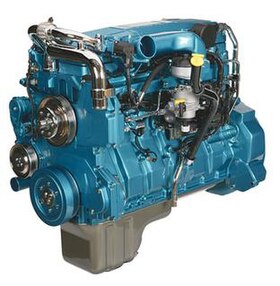Navistar DT engine
| Navistar DT engine | |
|---|---|
 |
|
| Overview | |
| Production | 1984-present |
| Combustion chamber | |
| Configuration | Inline-6 |
| Displacement | 360-570 cubic inches |
| Cylinder bore | 4.59 inches |
| Combustion | |
| Fuel type | Diesel |
| Output | |
| Power output | 170-350hp |
The Navistar DT engine family is a line of mid-range inline-6 diesel engines. With horsepower ratings ranging from 170 hp (130 kW) to 350 hp (260 kW), the Navistar DT engines are used primarily in medium-duty truck and bus applications, although some versions have been developed for heavy-duty regional-haul and severe-service applications. Prior to 1986 Navistar International, then known as International Harvester Company, used the DT engine in farm and construction equipment.
The DT engines are of a wet-sleeve design. This means that the cylinder wall (sleeve) is a separately machined part that fits into the cylinder bores cast into the engine block. The cylinder sleeve is in contact with the engine coolant, hence the "wet"-sleeve.
Navistar claims that the wet-sleeve design enhances durability because the consistent wall thickness of the sleeve allows for consistent heat transfer, ensuring the cylinders stay round during thermal expansion. Additionally, they state that the hardened cylinder sleeve is more durable and wear resistant than a softer, cast-in wall. Also, the replaceable cylinder sleeves protect the block from damage (e.g. in case of foreign objects entering the cylinder) and can easily be replaced, which Navistar claims enables simpler restoration to original specifications. The wet-sleeve design also allows the engine to be rebuilt easily to factory specifications, sometimes without even removing the engine from the vehicle.
This design is opposed to parent bore engines, where the cylinder walls are machined out of the bores cast into the block. International states that the uneven thickness of the cylinder walls causes the cylinders to become out of round during thermal expansion, increasing wear. Also, damage to the cylinder wall requires more extensive work to repair.
From 1984 until late 1995, the DT engines used a Bosch pump-line-nozzle (PLN) mechanical direct fuel injection system. 1984 through 1992 DTs used a Bosch MW style pump, while the 1993-1995s used a Bosch P style pump, and starting what was called New Generation Diesel engine design, which is still the same basic block design. Mechanical injection was still utilized in trucks up into the 1997 year, but this is rare. In 1994, due to tightening emissions regulations, the engines were redesigned to use electronically controlled unit direct fuel injection. From 1994 to 2004, the engines used HEUI (Hydraulically actuated Electronically controlled Unit Injection) injectors, co-developed by Navistar and Caterpillar. [1] From 2004 to 2009, the engines use International's Electro-Hydraulic Generation Two (G2) unit injectors.
...
Wikipedia
